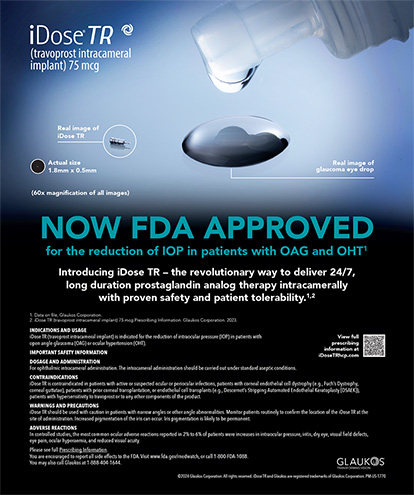MEDICATION PRACTICES
Peri- and Postoperative Medications: What Is the Standard of Care?
By Luis Cordovés, MD

Defining the standard of care for peri- and postoperative medications in cataract surgery is a tricky matter. Until recently, ophthalmic surgeons relied mostly on eye drops and subconjunctival injections as the means of drug administration in relation to surgical procedures. Recently, the advent of intracameral injections and other types of pharmacologic delivery has produced a shift toward so-called dropless cataract surgery, which aims to be less dependent on patients’ adherence to postoperative drug regimens. Luis Cordovés, MD, takes a look at the research on dropless surgery and suggests that postoperative topical corticosteroids and nonsteroidal anti-inflammatory drugs are here to stay.
DEVICE INNOVATION
A Variable Focus IOL
By Sean McCafferty, MD

Intuor Technologies is developing the Conexus Lens, a variable hyperfocal IOL to be implanted at the time of cataract surgery. This IOL changes power inside the eye to allow the patient to vary the associated focal distance at will by more than 12.00 D. The lens enables a patient to focus at 2 inches (a normal 25-year-old cannot focus any closer than 15 inches). This represents a sixfold increase in magnification, allowing the image to subtend a 36-times greater area of the retina, using the nondiseased portions of the retina to greatly improve visual acuity. The patient can then read and write at close distances and can see maximally at distance with a normal full field of view.
BUSINESS ISSUES
Cheap Is Cheap
By Dan Alexandre Lebuisson, MD

The low-cost LASIK model is based on extreme simplification of existing products and services. Such no-frills practices supply and perform only what is necessary. They pay employees well and expect more productivity, use the Internet to sell directly to the customer, and charge for a lot of things that people take for granted. In order to compete against low-cost providers, practices must invest their intangible capital—the good name and reputation of the surgeon—and maximize flexibility for patients.
Pearls for Keeping LASIK Volume up
By Jeffery J. Machat, MD, and Sondra Black, OD


LASIK volumes have been down for nearly a decade. What techniques can practices use to maintain or increase surgical volume in a difficult market? For Crystal Clear Vision, the one overarching strategy that seems to work best is communication. It takes several forms, including communication with patients and with a network of optometrists. This article discusses some of the ways the practice keeps the lines of communication open to let patients and optometric colleagues know about the benefits of the range of services Crystal Clear Vision offers. n


